
The eastern copperhead, also known simply as the copperhead, is a species of venomous snake, a pit viper, endemic to eastern North America; it is a member of the subfamily Crotalinae in the family Viperidae.
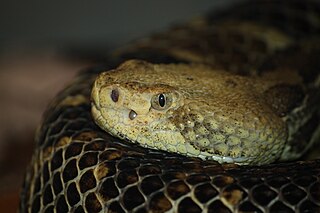
The Crotalinae, commonly known as pit vipers, or pit adders, are a subfamily of vipers found in Asia and the Americas. Like all other vipers, they are venomous. They are distinguished by the presence of a heat-sensing pit organ located between the eye and the nostril on both sides of the head. Currently, 23 genera and 155 species are recognized: These are also the only viperids found in the Americas. The groups of snakes represented here include rattlesnakes, lanceheads, and Asian pit vipers. The type genus for this subfamily is Crotalus, of which the type species is the timber rattlesnake, C. horridus.

The Snake Temple, also known as the Temple of the Azure Clouds, is a Chinese temple within George Town in the Malaysian state of Penang. Located at Bayan Lepas, the temple is well-known for being a refuge of resident snakes, said to be reincarnated disciples of the deified Buddhist monk Master Qingshui, to whom the temple is dedicated.
Tropidolaemus huttoni is a little-known species of pit viper, a venomous snake in the subfamily Crotalinae of the family Viperidae. The species is endemic to the southern Western Ghats of India. There are no subspecies that are currently recognized. Little is known about this species, as this species is known only from two young individuals, based on which it was first described in 1949. Despite long-term and targeted herpetological surveys in the particular hill range (Meghamalai), it has never been re-sighted there or elsewhere since then.

Craspedocephalus gramineus, known as the bamboo pit viper, Indian green pit viper, or common green pit viper, is a venomous pit viper species found in the southern and north eastern parts of India. No subspecies are currently recognized.
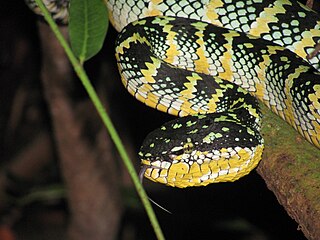
Tropidolaemus, the temple pit vipers, is a genus of pit vipers in the subfamily Crotalinae of the family Viperidae. Member species are native to southern India and Southeast Asia. Five species are recognised as being valid, and none of these species has subspecies.
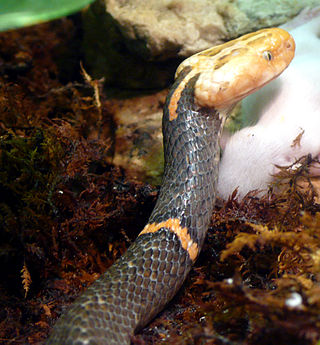
Azemiopinae is a monogeneric subfamily created for the genus Azemiops that contains the viper species A. feae and A. kharini. They are commonly known as Fea's vipers. No subspecies are recognized. The first specimen was collected by Italian explorer Leonardo Fea, and was described as a new genus and new species by Boulenger in 1888. Formerly considered to be one of the most primitive vipers, molecular studies have shown that it is the sister taxon to the pit vipers, Crotalinae. It is found in the mountains of Southeast Asia, in China, southeastern Tibet, and Vietnam. Like all other vipers, they are venomous.

Tropidolaemus wagleri, more commonly known as Wagler's pit viper, is a species of venomous snake, a pit viper in the subfamily Crotalinae of the family Viperidae. The species is endemic to Southeast Asia. There are no subspecies that are recognized as being valid. It is sometimes referred to as the temple viper because of its abundance around the Temple of the Azure Cloud in Malaysia.
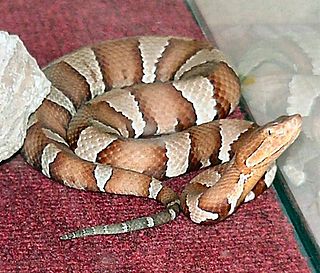
Agkistrodon contortrix pictigaster was formerly a venomous pit viper subspecies found in the Trans-Pecos region of the United States in western Texas, and northeastern Mexico. However, recent taxonomic changes do not recognize the Trans-Pecos copperhead as a valid taxon.
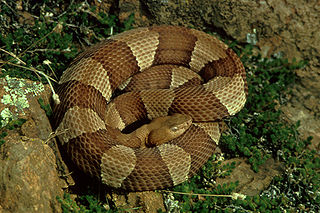
Agkistrodon laticinctus, commonly known as the broad-banded copperhead, is a venomous pit viper species, formerly considered a subspecies of Agkistrodon contortrix, which is found in the central United States, from Kansas, through Oklahoma and throughout central Texas.
Bamboo snake may refer to:
Rattlesnake pilot may refer to:
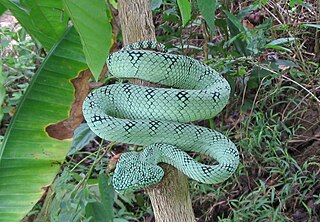
Tropidolaemus philippensis is a species of venomous snake in the subfamily Crotalinae, the pit vipers. It is endemic to western Mindanao and some portions of western Leyte, the Philippines. Its common name is South Philippine temple pit viper.

The Bornean keeled green pit viper or North Philippine temple pit viper is a pit viper species native to Brunei, Indonesia, Malaysia, and the Philippines. Until 2007, this species was considered part of the Tropidolaemus wagleri species complex.
Agkistrodon howardgloydi is a species of venomous snake, a pit viper in the subfamily Crotalinae of the family Viperidae. The species is endemic to Central America. It is most commonly called castellana, but it has also been called the southern cantil, Gloyd's moccasin, and a number of other colloquial names. It is a rare species with a relatively small geographic distribution in the tropical dry forest on the Pacific coast of Honduras, Nicaragua, and extreme northwest Costa Rica. A. howardgloydi is a stout, medium-sized snake with a maximum total length of 96 cm (38 in). It is a viviparous species, with females giving birth in the rainy season from May to August. No clinical reports on envenomation had been published, but laboratory texts and analysis indicate the venom is highly toxic and similar to its close relative Agkistrodon bilineatus, and potentially lethal.
Angus Finlay Hutton was a British naturalist born in India. Working in the High Wavy range, he discovered a species of pit viper that is now named after him as Hutton's pit viper. He also collected a species of bat that was later named as Salim Ali's fruit bat after Indian ornithologist Salim Ali. Until his death is 2016, Hutton was the oldest living member of the Bombay Natural History Society (BNHS). He helped set up butterfly gardens in Southeast Asia before settling in Queensland, Australia.
Ten Deadliest Snakes with Nigel Marven is a twelve-part wildlife documentary series from 2013 to 2017. It began airing on Eden Channel in 2013. Seasons 1 and 2 were also broadcast on Animal Planet Europe, while season 3 was premiered on Nat Geo Wild UK and later screened on Nat Geo Wild Europe & Africa in 2017. It is presented by Nigel Marven, who travels around the world and in each hour-long episode he counts down his list of ten deadliest snakes in each different country or continent. The series is produced by Image Impact.












